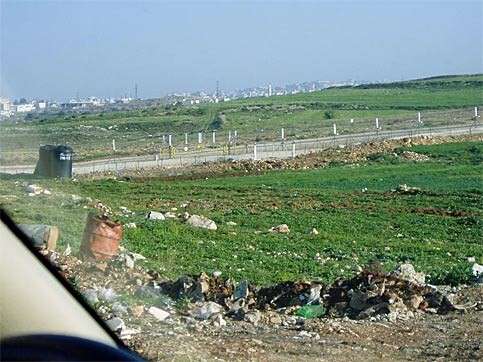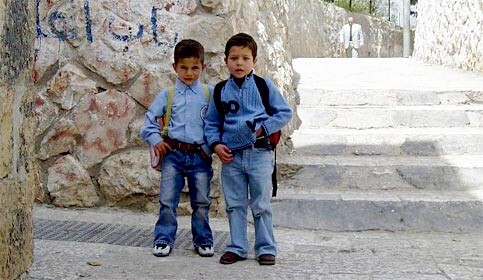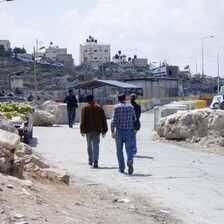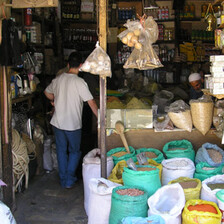
An electrified fence segment of Israel’s West Bank Barrier, near Ramallah.
Around Ramallah, the Apartheid Wall is still in the form a snaking stretch of electrified barbed wires surrounded by military roads and minefields, rather than the familiar slabs of concrete seen in other cities. A 5-minute drive towards the nearby village of Rafat, situated between Ramallah and Jerusalem, brings one face-to-face with three layers of wall in plain sight. The wall separating Jerusalem from its Arab suburbs of Beit Hanina, Shu’fat, and al-Ram, extend well north to encircle the Jerusalem airport, while excluding the concentrations of Arab neighborhoods surrounding the airport. The wall then loops back to insulate the airport from next-door Rafat, then loops back again to surround the Israeli military camp on the other side of the village. As a result, this small village is closely surrounded by wall from three sides, and joined only to the slightly bigger enclave of Ramallah by a narrow road.
Inside the Apartheid Wall, these Palestinian enclaves which were formerly booming cities, now more closely resemble ghettoes in the full sense of the word. The physical entrapment and hopelessness of the populace leads to apparent chaos. The measured statements of PA officials are contradicted by miles of graffiti on the walls of every building in city centers: “no to the treasonous Geneva Accords”, “no to negotiations”, and “we will remember the martyr so-and-so”. These slogans are interspersed with thousands of portraits of Palestinians martyrs - mostly ordinary Palestinians who suddenly lost their life to Israeli violence. A few steps from the Church of Nativity, we see a brand-new poster of an 11-year-old child who was killed in Bethlehem the prior week. On the side of a store in Ramallah we see a tattered old poster of a handsome young man. An acquaintance of mine informed me the guy was his cousin: “the Israelis killed him just 4 months after he got married.” Everyone knows or is related to someone who was killed, it seems.
Before our trip, I actually attempted to relieve my wife’s natural anxieties by looking up some statistics, thinking I can prove how small the chance is of getting shot. I went to the Red Cross website and downloaded the latest numbers. Wanting to make the trip as palatable as possible, I picked the most conservative numbers I can find, the ones counting only civilian casualties while excluding anyone with a Palestine authority uniform, anyone belonging to any resistance group, or even any victims of Israeli extra-judicial assassinations. Whereas, as I had expected, the chance of actually getting killed in Ramallah was not that high, I shocked myself by the number of Palestinians injured: 5000 people in the Ramallah district over the past 4 years. Compared to a population of just under 250,000, according to a 1999 census, that’s one Ramallah resident injured in the Intifada out of every 50, usually from Israeli gunfire. That means a short walk in the crowded downtown area guarantees we will pass or encounter at least a handful of Intifada casualties - not very reassuring!
Adding to the sense of captivity is the Israeli economic control of the Palestinian areas. Having boycotted Israeli products in the USA, I was surprised to see those Israeli products stocking the shelves of most stores in the West Bank. What I was told was that it was very hard to find other products simply because the West Bank has become an enormous captive economy. With Israel controlling the borders, Israeli products can move around more easily than others, while Palestinian products from the West Bank face export restrictions. Even Palestinian agricultural products grown in one village on the West Bank have a hard time being transported for sale in main West Bank markets. For instance, many villages are completely isolated, roads leading to them permanently blockaded, preventing produce trucks from going in. Even when trucks can make it, they need permits to travel on certain roads inside the West Bank and to cross Israeli checkpoints, permits that can be hard to get and are not issued as frequently as desired. Thus crops make it to the markets only occasionally, and after much delay.
Palestinian society itself is to blame for some of the economic complacency. I have seen Palestinians carelessly drinking Israeli Maccabee beer, when they could have drunk foreign or Palestinian beer, or forgone that sip of beer altogether. The same goes for Israeli coffee, soft drinks, chocolates, and other consumer products that can be considered luxuries for a people locked in a struggle for survival. Even worse is the official corruption openly discussed on the streets, of Palestinian officials selling cement to the Israeli companies building the Apartheid Wall, for example. On a more individual level, one sees the occasional tourist shop in the Old City of Jerusalem, though Palestinian-owned, proudly displaying pro-Zionist and anti-Palestinian T-Shirts and products. While the owner may have turned a buck from selling an Israeli army T-shirt, many foreign tourists and their acquaintances will have their minds poisoned by this propaganda, and Palestinians will ultimately suffer.
More can be done in terms of peaceful resistance to the occupation, had a national Palestinian leadership willed it. Aside from boycotting Israeli products, a serious effort can be mounted to break the mantle of the Israeli permit and travel-restriction system. Every Palestinian wishing to travel is faced with the dilemma, effectively accepting and acknowledging Israeli rule by applying for that permit, or challenging Israeli rule and bypassing the roadblocks, at great personal risks. Had a collective decision been made to boycott Israeli permits and to always bypass the checkpoints when traveling, the personal risk would be shared and the oppressive Israeli roadblocks would remain empty and rejected. Instead, the PA officially endorses the system and adds legitimacy to Israeli roadblocks by acting as an intermediary and helping Palestinians in obtaining those permits. Thus business moves forward, at the expense of national priorities.
In contrast to this official complacency, a large number of non-governmental organizations and local initiatives attempt to compensate by taking small steps on the ground towards a self-reliant society. During our stay, we got the opportunity to visit Birzeit University, where a nascent journalism academy is busy educating a cadre of Palestinian youth in the importance of the written and spoken word. The students get to run the university’s small TV and radio stations, under the guidance of experienced Palestinian journalists. Another NGO, al-Haq (“Law in the Service of Man”), was conscientiously documenting all the human rights abuses in Palestine, whether committed by the Israeli authorities or by the Palestinian Authority. We got to see an exhibition of their photos and other documents exposing Israeli collective punishment, a war crime under International law. The exhibition took place at the Sakakini Cultural Center in Ramallah, another institution working hard at educating the population and providing an outlet for artistic creativity. Another such institution we visited is the al-Qattan Center, an NGO focusing on educating teachers and on developing the educational curriculum in the Palestinian “self-rule” areas, thus asserting our independent identity.

Schoolchildren on their way home in East Jerusalem (at 12:14 PM), after only half a day of school, typical in that city due to overcrowdedness and underfunding of the Arab schools. (March 28, 2004)
In Jerusalem, we met the founders of the Faisal Husseini Foundation, who are now engaged in an ambitious project to raise money to support public health and education in the neglected East Jerusalem. Whereas Israel considers all of a Jerusalem as its unified capital, the Israeli municipality spends very little money on the Arab part of the city, reducing it to a ghetto. Touring the Old City, for example, I could not find a single garbage bin to throw my trash, forcing me to add to the litter which gives a false image of Arab Jerusalem as a backward, barbaric city.
In contrast, I could not escape the big Israeli street cameras poised on every street corner and covering every inch of the Old City, monitoring every step of the city’s quarter-million Palestinian residents. Under the Israeli system, Jerusalem schools receiving money from the municipality must teach an Israeli curriculum in Hebrew, aimed at erasing the Palestinian identity of the children and teaching them a concocted Israeli version of history. The Faisal Husseini Foundation attempts to resist this trend by raising money to support alternative schools that teach a Palestinian curriculum and keep the children away from the streets and drugs.
By and large, Palestinians in these enclaves entertain little hope of liberating themselves by means of a breakthrough in either negotiations or military operations. Few foresee and impending end for the occupation, a dismantling the illegal colonies, or even the Apartheid Wall falling down. For the majority of Palestinians, resistance today consists of mere survival - “Sumud” in Arabic - or continuing to exist on their land and strive towards a normal life despite all the obstacles that Israel hurls in their way in an attempt to make them leave.
Dr. Saber Zaitoun is the pseudonym of a Palestinian-American in his thirties. Dr. Zaitoun grew up under Israeli occupation and first came to the USA during the first Intifada to finish his education. He is married, and currently teaches at a University on the East Coast. For more information about his visit to Palestine, please see www.triptopalestine.com.





